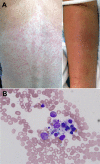Novel paramyxovirus associated with severe acute febrile disease, South Sudan and Uganda, 2012
- PMID: 24447466
- PMCID: PMC3901491
- DOI: 10.3201/eid2002.131620
Novel paramyxovirus associated with severe acute febrile disease, South Sudan and Uganda, 2012
Abstract
In 2012, a female wildlife biologist experienced fever, malaise, headache, generalized myalgia and arthralgia, neck stiffness, and a sore throat shortly after returning to the United States from a 6-week field expedition to South Sudan and Uganda. She was hospitalized, after which a maculopapular rash developed and became confluent. When the patient was discharged from the hospital on day 14, arthralgia and myalgia had improved, oropharynx ulcerations had healed, the rash had resolved without desquamation, and blood counts and hepatic enzyme levels were returning to reference levels. After several known suspect pathogens were ruled out as the cause of her illness, deep sequencing and metagenomics analysis revealed a novel paramyxovirus related to rubula-like viruses isolated from fruit bats.
Keywords: Paramyxoviridae; Sosuga virus; South Sudan; Uganda; bats; diagnostics; metagenomics; rash; rubula-like virus; viruses; zoonosis.
Figures



References
-
- Lamb RA, Parks GD. Paramixoviridae: the viruses and their replication. In: Fields BN, Knipe DM, Howley PM, editors. Fields virology. 5th ed. Philadelphia: Lippincott, Williams and Wilkins; 2007. p. 1449–96.
Publication types
MeSH terms
Substances
LinkOut - more resources
Full Text Sources
Other Literature Sources

